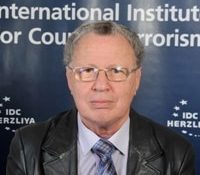Analysis
Gaza – what can be done? Six expert views
Category: Regional Issues
The BICOM research team has commissioned six experts to give their views on whether a war between Hamas and Israel is inevitable, what can be done to break the cycle of violence witnessed over the last few months along the Gaza border, and whether a “grand deal” or a long-term truce between Israel and Hamas is possible.
Ilan Goldenberg
Ilan Goldenberg is Senior Fellow and Director of the Middle East Security Program at the Center for a New American Security. From 2012 to 2013, Ilan served as a Senior Professional Staff Member on the Senate Foreign Relations Committee covering Middle East issues for Chairmen Kerry and Menendez. Ilan also served first as a Special Advisor on the Middle East and then as the Iran Team Chief in the Office of the Under-Secretary of Defense for Policy from 2009-13.
Is it a matter of when, not if, Israel and Hamas fight another major round of conflict?
On the one hand, Israel’s recent closure of Kerem Shalom to fuel and Egypt’s closure of Rafah are both bad signs we could be headed for conflict. And Hamas is looking for ways to put pressure on Israel and maintain its own political legitimacy in Gaza which push them towards continuing to fire rockets or support incendiary kites and balloons. However, on the positive side of the ledger, neither Israel nor Hamas really wants another major conflict. Neither side has much to gain from another war and they are both aware of the risks of the situation escalating out of control. That does not mean they will not stumble inadvertently into a conflict. But it does act as a check on all sides.
What should be done to break the cycle of violence witnessed over the last few months?
What we need is a short-term arrangement that addresses the three most urgent humanitarian concerns in Gaza: electricity, water, jobs. In exchange, Hamas should recommit to the ceasefire that’s been in place since 2014. The international donor community in close cooperation with Egypt and Israel should support short-term immediate projects that improve the water and power situation.
The Palestinian Authority should be encouraged to play a constructive role in this, but if they won’t support these immediate steps they should be bypassed. Israel is the most important player in trying to create jobs. It needs to find ways to allow more Gazan workers into Israel. It can also support industrial zones in Gaza where materials come in from the Israeli side and workers from the Gazan side. The goods are then produced and exported out of Gaza but create a new job market for Gazans. In exchange, Hamas would recommit to the ceasefire including committing to no rockets, tunnel attacks, or kites/balloons.
Is a “grand deal” or a long-term truce between Israel and Hamas possible? If so, what conditions must be met?
A long-term deal may be possible but will be incredibly challenging for all sides. Sadly it may only happen after another major conflict when all sides are forced to reconsider and think about if they really want to continue with this cycle of violence. Hamas would never agree to full disarmament and would insist on keeping its guns inside Gaza to enforce security, but it would have to agree to the destruction of the tunnels and its rocket stockpile. It would also have to agree that the ceasefire would apply to the West Bank and cease any terror actions there. In exchange, there would be a significant loosening of the Gaza borders and a major long-term economic program for Gaza including Industrial zones, a port, a large number of work permits for Gazans to work in Israel, and investment in long-term water and energy infrastructure. Since a strict long-term ceasefire between Hamas and Israel gives Hamas significant legitimacy and also reinforces the split between
Gaza and the West Bank, the ideal approach would actually be to embed all of this in an agreement between Hamas and Fatah which would allow the PA to slowly starting re-entering Gaza. But if that option is not doable then a long-term ‘hudna’ between Israel and Hamas is better than nothing.
Perhaps the greatest short-term stumbling block to all of this right now is that Israel will insist on the return of the remains of two IDF soldiers and a number of Israeli civilians that Hamas is currently holding. And Hamas will not agree to that unless there is a prisoner release. These are deeply charged and sensitive political questions but that negotiation should be separated from the broader negotiation on a long-term ceasefire that affects millions of people.
Kobi Michael

Kobi Michael is a senior research fellow at INSS. Among his primary research interests are peace and war studies; strategy; national security; civil-military relations; socio-military relations; peace maintenance; and the Israeli-Palestinian conflict. Dr Michael served as the deputy director general and head of the Palestinian desk at the Ministry for Strategic Affairs.
Is it a matter of when, not if, Israel and Hamas fight another major round of conflict?
Not necessarily. All the conditions are there on the ground for a new round of conflict and the probability is above 50 per cent. Yet, if both sides find themselves in another war it will not be because it is part of their strategic interests, and this situation is similar to the one in 2014 before Operation Protective Edge. In the last two weeks, Hamas have adopted a misperception of thinking that they are able to change the deterrence equation between Hamas and Israel by using flying fire kites to force Israeli communities in the Gaza border area to pressure the political echelons in Israel. They also feel that they are able to embarrass the IDF that is unable to tackle this primitive tactic because the IDF will not open fire against youngsters sending kites. But this is a misperception because they have not taken into consideration the internal political games within the Israeli coalition and pressure the government came under to respond. Therefore they have found themselves facing a very forceful response from Israel against military targets and restrictions at the border crossings in retaliation to the fire kites. The Egyptians are also in coordination with the Israelis, which could lead to complete collapse of the Hamas regime. As a result, Hamas are recalibrating their policy and may seek to reign in the number of flying fire kites. But we are dealing with a very high level of uncertainty and it is enough that one kite causes loss of life for Israel to retaliate very aggressively.
What should be done to break the cycle of violence witnessed over the last few months? Is a ‘grand deal’ or a long-term truce between Israel and Hamas possible? If so, what conditions must be met?
As of today, there is a higher probability that an agreement will happen in the future, even if there is no eruption. This is the tragedy of today. If there is another round of conflict, at the end both sides will find themselves with the same challenges as before the violence: they will still need to agree to a truce. Israel understands the option of Hamas demilitarising itself is not an option. But Israel can reach other understandings with Hamas that relate to security measures, such as what is and what isn’t allowed in security perimeter that is a 300m zone west of the border, stopping rocket attacks by Hamas or others group in the Gaza Strip toward Israel, solving the humanitarian crisis (the other part of the security equation and actually is an escalating factor in instability in the Strip), and preventing the build-up of military infrastructure. Both sides can also reach to understandings regarding civilian affairs, including opening up the border crossings for more goods, increase the fishing zones for Gaza fisherman, and to implement some of the infrastructure projects proposed earlier this year. If they can agree to these conditions, it is not inconceivable for some Gazans to be allowed to travel and work in Israel on a daily basis. Not in the first stage, as both sides would need to accumulate trust, and this creates further improvement in the quality of life and economy of Gaza.
Israel is dealing with two independent Palestinian entities that are also hostile toward each other. The Gaza Strip is a semi-state entity ruled by Hamas and the probability of the PA returning to the strip and effectively ruling there is very low. Although we hear reports of progress between reconciliation efforts between Hamas and the PA, led by Egypt, but even if they reach a certain agreement, they will not be able to conduct and preserve it for a long time, due to the fragmentation of the Palestinian political scene, which is embolic of the fragmentation in the wider Middle East – Hamas belongs to the Muslim Brotherhood camp, supported by Turkey and Qatar, a red flag for the Egyptians and Saudis who led the other camp of the pragmatic, Sunni Arab countries including the PA. The political struggle between these two camps is something much deeper and complicated and seeps into the intra-Palestinian struggle. This means Israel has to develop a distinguish strategy toward the Gaza Strip in comparison to its strategy toward the West Bank. There will be some tensions and contradictions between those two strategies and Israel will need tobe able to manoeuvre between them smoothly.
Celine Touboul

Celine Touboul is Deputy Director General and senior researcher of the Economic Cooperation Foundation. Touboul is leading ECF’s work in regard to all policy, economic and security issues related to the Gaza strip, and is taking part in ECF’s policy planning efforts related to the Israeli-Palestinian peace process. Concurrently, Celine works as a senior advisor with Jerusalem expert Daniel Seidemann and his NGO, Terrestrial Jerusalem.
Is it a matter of when, not if, Israel and Hamas fight another major round of conflict?
I don’t think another round of conflict is inevitable, but if all the players continue to act as they have done over the last two years, then the next war is just a question of time. There are three factors that can lead to such a war: lack of a clear ceasefire arrangement that defines clearly the rules of the game and the commitments of each side to maintain it; the acute financial and humanitarian crisis in Gaza; and dead end in the internal Palestinian reconciliation process. Unless these challenges are addressed by a different policy, then there is a big chance we will face another war in Gaza sooner rather than later.
What should be done to break the cycle of violence witnessed over the last few months?
These cycles of violence are characterized by both Israel and Hamas continuously reacting to what they interpret as the other side crossing a red line, by their attempts to test the limits of the other side and to enlarge their respective room of maneuver. This pattern is creating repeated waves of escalation. In this context, Israel acts primarily by means of deterrence in order to prevent Hamas to increase its military capacity. It does so whilst trying not to harm Hamas too much in order to preserve Hamas’ ability to enforce Gaza the ceasefire and not risk a total vacuum in Gaza. Beyond this tactical aims, the problem is that Israel has not defined its objectives towards Gaza and the way it wants to address the causes of Gaza chronical instability. In that context, there is a significant gap between Israel’s military and political echelon – the military have internalised the fact that to enhance Gaza stability we need to address the economic distress in Gaza, whilst the political echelon is solely relying on military power to solve Gaza crisis. Deterrence is not a sufficient strategy to avoid a war in Gaza. To stabilize Gaza, Israel needs to define a comprehensive strategy aimed at supporting and actively encouraging the PA to return to governing Gaza, in a coordinated effort with Egypt, the US, and other significant donors to Gaza. It requires Israel to outline a menu of significant measures to incentivize the PA to take responsibility in Gaza, including a substantial easing of the restrictions at Gaza border crossings along with political incentives. If, in spite of these efforts, the PA continues to refuses to take responsibility in Gaza, a contingency plan should be developed that would enable Israel to advance those steps while bypassing the PA.
Is a ‘grand deal’ or a long-term truce between Israel and Hamas possible? If so, what conditions must be met?
The idea of a long-term truce between Israel and Hamas is problematic for two reasons. First, a deal between Israel and Hamas would deepen the divide between the West Bank and Gaza and therefore further harm the prospects of the two state solution. This is even more problematic given that Israel has not seriously tried to engage and support positively the PA in order to reassure them and actively encourage them to return to Gaza. Second, a long-term truce will mostly focus on the terms of the cease fire between both sides, and on the restrictions at Gaza crossing. It will not actually address the main factor of instability in Gaza, which is Gaza current financial crisis, caused by the fact that most Gazans have lost their incomes (due to Hamas inability to generate enough incomes to pay for the salaries of its 43,000 Hamas employees and the PA’s decision to cut the wages of its 55,000 employees). A deal between Israel and Hamas will most likely make the PA more hostile toward Gaza and even less eager to come to terms with Hamas on the issue of Gaza civil servants’ salary. In that context, only if Israel decides to transfer directly to Gaza part of the taxes clearance revenues that it collects on behalf of the PA, a deal between Israel and Hamas could make a meaningful difference in regard to Gaza financial crisis. For obvious and legitimate reason, Israel is very much unlikely to make such decision. Furthermore, a deal between Israel and Hamas will not address the current water and energy crisis in Gaza, which is mainly due to the current governance vacuum prevailing in Gaza and to the reluctance of the PA to take responsibility for Gaza situation. Unlike Israel decides to consider Hamas as the legitimate address to advance projects in these sectors, a deal between Israel and Hamas will fail to address these challenges. Therefore, when considering the feasibility and potential impact of a deal between Israel and Hamas, the question that we need to ask ourselves is what Israel will actually be prepared to put on the table to strike a deal with Hamas. And while there is no doubt that Israel will need to offer significant measures to ensure Hamas’ commitment to a long-term ceasefire, the question is why not to offer these measures to encourage the PA to return to Gaza. This should be the equation.
Michael Koplow
Michael Koplow is Israel Policy Forum’s Policy Director, based in Washington DC. Before coming to the Israel Policy Forum, Michael was the founding programme director of the Israel Institute from September 2012 through September 2015. Michael is a regular contributor to Foreign Affairs and Foreign Policy magazines, Michael writes the weekly “Koplow Column” and edits IPF’s “Matzav Blog.”
Is it a matter of when, not if, Israel and Hamas fight another major round of conflict?
Given that the underlying structure and conditions – Israel’s isolation of Gaza and pressure on Hamas designed to bring its downfall, and Hamas’s use of violence to try and force Israel into concessions – that led to the last three conflicts in Gaza have not changed, another major round between the two sides at some point is perhaps the most predictable element of the Israeli-Palestinian conflict. Only a significant change in the strategy and tactics of either Israel or Hamas, such as Hamas foreswearing violence and returning Gaza to Palestinian Authority control or tacit Israeli recognition of Hamas by ending the blockade and agreeing to a long-term ‘hudna,’ will prevent the inevitable round of fighting that is to come. Any conflict that breaks out is also likely to follow the same pattern as the last three, in the sense that each side will be dragged into a larger and longer escalation than either wants, and the status quo once the fighting is over will not have changed; Israel will not launch a ground invasion designed to topple Hamas by force, and Hamas will not succeed in forcing any significant concessions such as ending the blockade or its own isolation.
What should be done to break the cycle of violence witnessed over the last few months?
The two most proximate factors causing the uptick in violence are the worsening of Gaza’s economic and humanitarian situation, which puts more pressure on Hamas to respond in the only way it knows how, and the resumption of rockets and mortars along with the introduction of incendiary balloons and kites, which puts more pressure on the Israeli government to respond in a more forceful manner. Ending the cash flow crisis through the resumption of Palestinian Authority payment of civil service salaries and funnelling aid through the United Nations for basic repair and improvement of the electricity grid and sewage treatment facilities subject to these measures ceasing immediately if rockets, mortars, and incendiary devices are not entirely shut down can temporarily break this cycle. It does not require Israel to recognize Hamas or Hamas to give up its position in Gaza, but it does the bare minimum necessary to remove the domestic political incentives that each side has to escalate things. If Hamas no longer feels as if the benefits of the latest iterations of violence directed toward Israel outweigh the costs since there is now something to lose, and the Israeli government no longer feels pressured to respond to images of burning fields in the Gaza periphery, it can bring both sides back from the brink of a larger conflagration that neither seems to want but that is bound to happen if the tit-for-tat provocations and responses continue for much longer.
Is a ‘grand deal’ or a long-term truce between Israel and Hamas possible? If so, what conditions must be met?
Both sides need to understand that the strategies they have respectively employed for the past decade have failed. Despite eliminating Hamas’s tunnels, cutting off its supply chain of dual-use materials, and trying to create domestic pressure on Hamas through the Gaza blockade, Israel is no closer to toppling Hamas from controlling Gaza. Despite the threat of rockets, mortars, and tunnels, and the public opprobrium brought to bear on Israel as a result of Palestinian casualties during Israeli operations, Hamas is no closer to having either Israel or the international community recognize it as a legitimate entity or ending its own and Gaza’s isolation. Each side needs to pull back and accept a suboptimal solution in order to achieve some of its aims; with Egyptian – and possibly American – assistance, a deal can be brokered in which Israel enables significant aid and reconstruction efforts to alleviate the truly awful humanitarian crisis in Gaza and begin the process of creating a sustainable economy, and Hamas subordinates its political authority over Gaza to the Palestinian Authority. This diminishes Hamas’s role in Gaza and decreases the chances of continuing violence from the territory aimed at Israel, which is Israel’s primary desire, and grants Hamas some form of public relations victory and validation by allowing it to claim a role in ending Gaza’s isolation. It leaves neither side completely happy, but that’s what compromise is made of, and it alters the underlying foundation upon which the continuous rounds of fighting have been built. This scenario looks more like a long-term truce than a permanent grand deal and is always subject to falling apart, but it is something that can be achieved in the current political environment and with the current leadership of both sides.
Yaakov Lappin
Yaakov Lappin is a military and strategic affairs analyst and holds positions of Associate Researcher at the Begin-Sadat Center for Strategic Studies and the Israel correspondent for IHS Jane’s Defense Weekly and for the Jewish News Syndicate (JNS.org).
Is it a matter of when, not if, Israel and Hamas fight another major round of conflict?
A war between Israel and Hamas is not inevitable. Decision-makers on both sides are not interested in entering into a full-scale conflict. Israel, for its part, views no realistic alternative to Hamas as Gaza’s ruler and doubts its ability to conduct regime change there through military means. To put it metaphorically, Fatah is unlikely to ride into Gaza from the West Bank on board Israeli tanks. Hamas’s leaders, for their part, despite their fundamentalism, understand that a war with Israel would bring them no benefits at this time.
However, the explosive and unpredictable nature of the situation could lead to a major round of conflict nonetheless. Hamas is prepared to risk an escalation due to its desperate effort to lift the security blockade and avoid a collapse of the Gazan economy. Yet it is unwilling to offer meaningful concessions regarding its force build-up that would allow Israel to relax the blockade. Hamas remains locked in hostile relations with the Palestinian Authority and Egypt too, meaning that its isolation is pushing it into increasingly dangerous gambles – in the form of violent pressure tactics designed to get money flowing into Gaza.
What should be done to break the cycle of violence witnessed over the last few months?
A formula for improving Gaza’s economy, without handing Hamas material or propaganda gifts that would strengthen its status, would go a long way to calming tensions in Gaza. This could involve finding ways of encouraging economic growth, increasing exports, and creating investment in Gaza over the head of Hamas. That could push back the threat of an economic collapse, while avoiding the unwanted scenario of handing Hamas the gift of claiming another propaganda victory, by allowing it to claim that its violent tactics “forced” Israel to ease the blockade. Any strengthening of Hamas’s narrative would automatically come at the expense of the Palestinian Authority on the Palestinian street – another factor that Israel must keep in mind.
Is a “grand deal” or a long-term truce between Israel and Hamas possible? If so, what conditions must be met?
A grand deal or a long-term truce is highly unlikely. This is because Hamas is unwilling to change its primary ideological commitment to destroying Israel, and to eventually overthrowing the Palestinian Authority government in the West Bank. A long-term truce that Hamas would agree to would be designed to facilitate an ambitious arms buildup program in Gaza, which would be detrimental to Israel’s security and long-term interests. Under present conditions, Israel is able to effectively respond to threats emerging from Gaza without going to war – such as the effective anti-tunnel systems now being established.
However, it is possible to reach a more modest and shorter-term understanding with Hamas, in which it would be permitted to continue to rule Gaza if it ceases all projectile attacks on southern Israel. An economic aid program, as mentioned in my answer to question 2, could then stabilize the situation. Israel should not, however, accept any demands that would aid Hamas’s future military wing build-up, or strengthen its political status in the region. It is also worth keeping in mind that Hamas continues, every day, to try and orchestrate terrorist atrocities against Israeli cities, via cells in the West Bank.
Ely Karmon

Dr Ely Karmon is a Senior Research Scholar at The International Institute for Counter-Terrorism (ICT) and Senior Research Fellow at the Institute for Policy and Strategy at The Interdisciplinary Center (IDC) in Herzliya, Israel. He previously served as advisor to the Israeli Ministry of Defense and the Anti-Semitism Monitoring Forum of the Israeli Government Secretariat.
Is it a matter of when, not if, Israel and Hamas fight another major round of conflict?
Since Operation Protective Edge in 2014, Hamas has restrained itself from attacking Israel with missiles due to IDF’s achievements in destroying its missiles with the Iron Dome system and identifying and destroying its attack tunnels. However, the 2014 war was perceived as a victory by the Hamas leadership, and particularly the Palestinian youth in Gaza and the West Bank (i.e. they saw a small hybrid organisation resist the Israeli army for over 50 days, longer than even Hezbollah achieved in the 2006 Second Lebanon War). Only under the pressure of Egypt and of increasing civilian destruction and causalities did Hamas stop its terrorist attacks and missiles’ fire at Israel.
The wave of individual terrorism by knifings and car ramming since September 2015, in great part due to Hamas’ incitement, also failed, due to new Israeli security methods of identifying potential terrorists. On the regional arena, the organisation lost most of its support and entered in a period of great political isolation and conflict with the Palestinian Authority (PA), as Chairman Mahmood Abbas took a series of painful economic sanction against Gaza, thus deepening the already dire economic and humanitarian crisis in the Strip.
By the spring of 2018, Hamas decided to hold the popular ‘Great March of Return’ on the Gaza border to mark 70 years of the Nakba [Palestinian catastrophe] and also to protest the transfer of the American embassy to Jerusalem. However, the strategy of sending thousands of Gazans across the border in Israel hoping to pass the fence, possibly occupy Israeli villages and take soldiers hostages, failed because of the IDF strategy of containment, which produced a relatively low number of militant and civilian causalities, as well as the failure to mobilise the great majority of the population for a long period of violence. The new primitive but efficient method of producing fires and arson inside Israel by kites and balloons has raised the tension at the Gaza border and until the last days it seemed that Hamas was taking the risk to provoke the Israeli government, under growing public pressure, to take more severe steps in the Strip, including a ground operation.
Hamas is using a strategy of brinkmanship by destabilising the normal life of the Israeli citizens near the border with Gaza, trying to push Israel as much as possible into accepting their demands of ending the blockade of Gaza without paying a real political price or provoking a real war. But in such a strategy of brinkmanship, you never know when there will be an incident, like the killing of Israeli civilians or a great number of Palestinian casualties, that ignites a new round of conflict. Also, the Israeli government is under huge pressure from the population in the south to deal with the fires along the Gaza border, which have burnt close to 10,000 acres of Israeli land, and the tension of living under permanent alert.
As attested during the last incidents over the weekend (20-22 July), with the continuation of the arson strategy, some explosive attacks on the fence and finally the killing of an Israeli soldier by a sniper, the Israeli government decided on a harsh military retaliation by its air force against some 60 important Hamas military targets and signalled that it is ready to decide on a new ground operation. It seems Hamas has finally blinked and stopped just before it was too late, asking for a ceasefire through Egypt and the UN.
What should be done to break the cycle of violence witnessed over the last few months? Is a “grand deal” or a long-term truce between Israel and Hamas possible? If so, what conditions must be met?
The basic facts on the ground have not changed and, in my opinion, Hamas will continue to challenge Israel and the PA as well as continue the process of rapprochement with the Iranian regime, as Turkey and Qatar will find it increasing difficult to “deliver the goods”.
I have never believed in the idea of a ‘hudna,’ or long-term truce, although this idea was proposed at the peak of the Second Intifada by the late Sheikh Ahmed Yassin, the Hamas leader. There is no guarantee that Hamas won’t simply sign a long-term truce and then decide after several years that their political strategic situation is more favourable and subsequently provoke a new war. Ideologically, at the difference of the secular Fatah movement which controls the PA, I don’t see the radical religious movement ready for a real change in its final goals. Therefore, I don’t think it is possible to have a real deal with Hamas as long as their goal is ultimately the destruction of the State of Israel. Even the PA are not able to reach a deal with Hamas, mainly due to ideological, but also political and security reasons.
I have argued for many years that the Israeli strategy of containment of Hamas in Gaza by paying an expensive price in military operations every three to four years (in casualties, economically and psychologically for the population in southern Israel), is not a real solution. Israel should strive to destroy the military might of Hamas in Gaza and with support of Egypt and other moderate Arab states permit the PA to retake the control of the Strip and reconstruct its failed infrastructure through a Marshall economic plan, about which there is now talk behind the scenes.
Instead, in my opinion, our government seems more interested in building in the West Bank rather than dealing with Gaza on the strategic level and creating conditions for a long-term period of peace.


